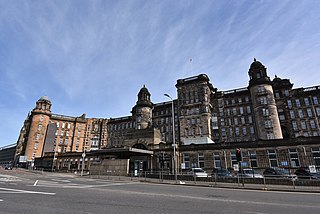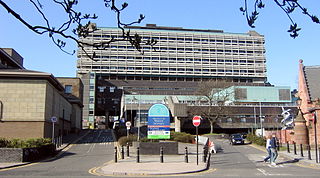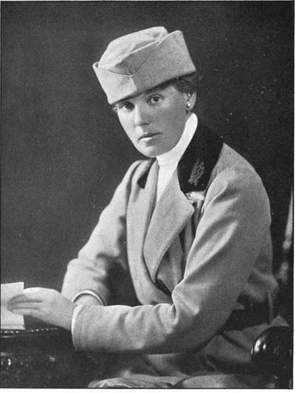
The Royal College of Surgeons of Edinburgh (RCSEd) is a professional organisation of surgeons. The RCSEd has five faculties, covering a broad spectrum of surgical, dental, and other medical and healthcare specialities. Its main campus is located on Nicolson Street, Edinburgh, centred around the 18th century Surgeons' Hall. The campus includes Surgeons' Hall Museums, a medical and surgical library, a skills laboratory, a symposium hall, administrative offices and a hotel. A second UK office was opened in Birmingham in 2014 and an international office opened in Kuala Lumpur, Malaysia, in 2018.

The Glasgow Royal Infirmary (GRI) is a large teaching hospital. With a capacity of around 1,000 beds, the hospital campus covers an area of around 8 hectares, and straddles the Townhead and Dennistoun districts on the north-eastern fringe of the city centre of Glasgow, Scotland. It is managed by NHS Greater Glasgow and Clyde. It was originally opened in 1794, with the present main building dating from 1914, with a major extension completed in 1982.

The Western Infirmary was a teaching hospital situated in Yorkhill in the West End of Glasgow, Scotland, that was managed by NHS Greater Glasgow and Clyde. It was opened in 1874 and closed in 2015.

The Royal Infirmary of Edinburgh (RIE) was established in 1729, and is the oldest voluntary hospital in Scotland. The new buildings of 1879 were claimed to be the largest voluntary hospital in the United Kingdom, and later on, the Empire. The hospital moved to a new 900 bed site in 2003 in Little France. It is the site of clinical medicine teaching as well as a teaching hospital for the University of Edinburgh Medical School. In 1960 the first successful kidney transplant performed in the UK was at this hospital. In 1964 the world's first coronary care unit was established at the hospital. It is the only site for liver, pancreas, and pancreatic islet cell transplantation in Scotland, and one of the country's two sites for kidney transplantation. In 2012, the Emergency Department had 113,000 patient attendances, the highest number in Scotland. It is managed by NHS Lothian.

The University of Glasgow School of Medicine, Dentistry & Nursing is the medical school of the University of Glasgow, Scotland, and is one of the largest in Europe, offering a 5-year MBChB degree course. It is ranked 2nd in the UK for medicine by The Times Good University Guide 2018 and joint 1st in the UK by the Complete University Guide 2021. The School of Medicine uses lecture-based learning, problem-based learning and Glasgow's case-based learning.

Surgeons' Hall in Edinburgh, Scotland, is the headquarters of the Royal College of Surgeons of Edinburgh (RCSEd). It houses the Surgeons' Hall Museum, and the library and archive of the RCSEd. The present Surgeons' Hall was designed by William Henry Playfair and completed in 1832, and is a category A listed building.

Dame Anne Louise McIlroy, known as Louise McIlroy, was a distinguished and honoured Irish-born British physician, specialising in obstetrics and gynaecology. She was both the first woman to be awarded a Doctor of Medicine (MD) degree and to register as a research student at the University of Glasgow. She was also the first woman medical professor in the United Kingdom.

Charles Frederick William Illingworth was a British surgeon who specialised in gastroenterology. Along with a range of teaching and research interests, he wrote several surgical textbooks, and played a leading role in university and medical administration.

Douglas James Guthrie was a Scottish medical doctor, otolaryngologist and historian of medicine.

John Menzies Campbell FRSE FDS RCSEd, DDS was a Scottish dentist and dental historian who became a collector of dental books, paintings and dental instruments. At the time of his death he had amassed what was regarded as one of the largest collections of dental memorabilia in the world. He bequeathed his collection of pictures and instruments to the museum of the Royal College of Surgeons of Edinburgh (RCSEd) where it formed the Menzies Campbell Dental Museum, and is now known as the Menzies Campbell Collection. His books and dental advertisements were left to the Royal College of Surgeons of England (RCSEng).
Rebecca Strong was an English nurse who pioneered preliminary training for nurses.

The Edinburgh College of Medicine for Women was established by The Scottish Association for the Medical Education of Women whose leading members included John Inglis, the father of Elsie Inglis. Elsie Inglis went on to become a leader in the suffrage movement and found the Scottish Women's Hospital organisation in World War I, but when the college was founded she was still a medical student. Her father, John Inglis, had been a senior civil servant in India, where he had championed the cause of education for women. On his return to Edinburgh he became a supporter of medical education for women and used his influence to help establish the college. The college was founded in 1889 at a time when women were not admitted to university medical schools in the UK.
The Triple Qualification (TQ) was a medical qualification awarded jointly by the Royal College of Surgeons of Edinburgh, the Royal College of Physicians of Edinburgh and the Faculty of Physicians and Surgeons of Glasgow between 1884 and 1993. Successful candidates could register with the General Medical Council (GMC) and practise medicine in the United Kingdom. It was a route used by international medical graduates and those unable to gain entry to university medical schools, which included women in the late 19th century and refugee medical students and doctors throughout the 20th century.
Margaret Williamson Menzies Campbell FDS FRCSE was a Scottish surgeon and general practitioner, who is known for her work as an historian of women's medical education and practice and dentistry.

James Alexander Ross MBE, FRCSEd was a Scottish surgeon awarded the MBE for his service in the Second World War. He was a leading member of the surgical team which, in 1960, carried out the first successful kidney transplant in the United Kingdom. He served as president of the Royal College of Surgeons of Edinburgh.

John Campbell was a Scottish surgeon. He served as president of the Royal College of Surgeons of Edinburgh from 1832 to 1834. In that capacity he was the last president of the College to sit ex officio as a member of the Edinburgh Town Council, so ending a tradition dating from 1583. During his presidency the College made the most significant change of location in its history, moving from Old Surgeons Hall in Surgeons' Square to the present Playfair building in Nicolson Street.

Alice Lilian Louise Robson was a Scottish medical doctor and one of the first two women to be awarded a medical degree in Scotland.

James Dunsmure FRCSEd was a Scottish physician and obstetrician who, as his father had done before him, served as President of the Royal College of Surgeons of Edinburgh.
Extramural medical education in Edinburgh began over 200 years before the university medical faculty was founded in 1726 and extramural teaching continued thereafter for a further 200 years. Extramural is academic education which is conducted outside a university. In the early 16th century it was under the auspices of the Incorporation of Surgeons of Edinburgh (RCSEd) and continued after the Faculty of Medicine was established by the University of Edinburgh in 1726. Throughout the late 18th and 19th centuries the demand for extramural medical teaching increased as Edinburgh's reputation as a centre for medical education grew. Instruction was carried out by individual teachers, by groups of teachers and, by the end of the 19th century, by private medical schools in the city. Together these comprised the Edinburgh Extramural School of Medicine. From 1896 many of the schools were incorporated into the Medical School of the Royal Colleges of Edinburgh under the aegis of the RCSEd and the Royal College of Physicians of Edinburgh (RCPE) and based at Surgeons' Hall. Extramural undergraduate medical education in Edinburgh stopped in 1948 with the closure of the Royal Colleges' Medical School following the Goodenough Report which recommended that all undergraduate medical education in the UK should be carried out by universities.















